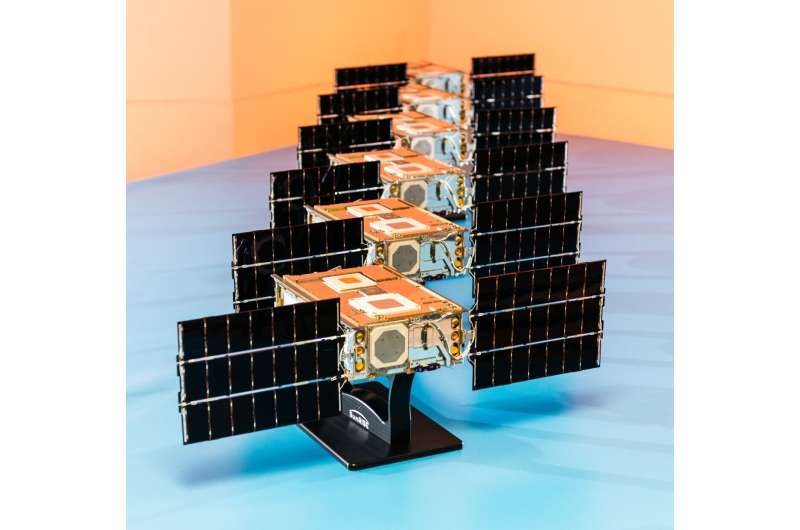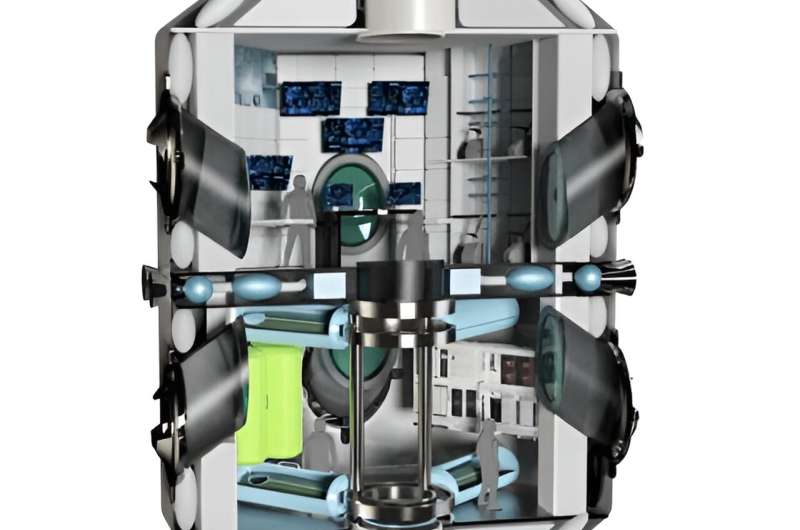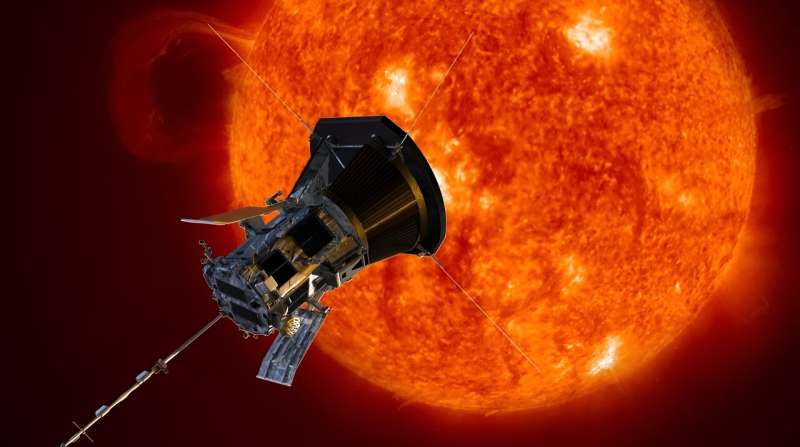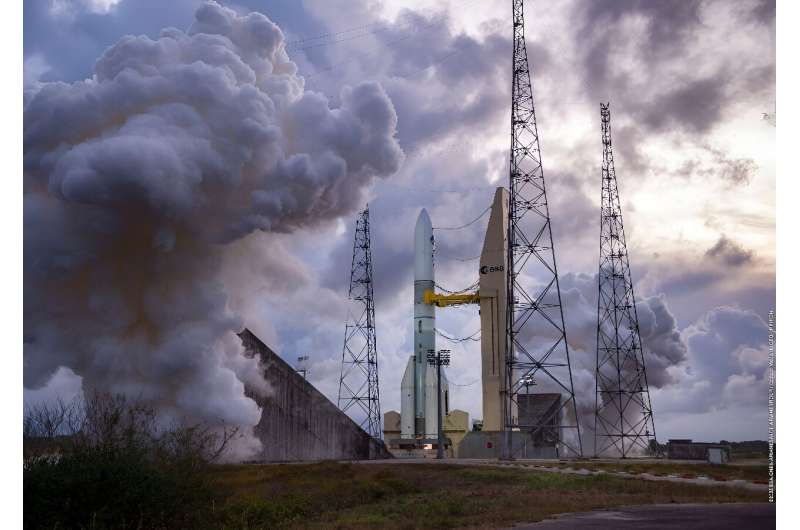
Copernical Team
NASA's 6-pack of mini-satellites ready for their moment in the sun

Most NASA missions feature one spacecraft or, occasionally, a few. The agency's Sun Radio Interferometer Space Experiment (SunRISE) uses half a dozen. This month, mission members completed the construction of the six identical cereal box-size satellites, which will now go into storage and await their final testing and ride to space.
A detailed design for a space station at sun–Earth L2

New ideas in space exploration come from all corners, and, by and large, the community welcomes anybody interested in the field. Having just read "A City on Mars," it seems that even people who disagree with the idea that the age of space settlement is imminent will be accepted into the fold by enthusiasts. Now, a new entrant has joined—Daniel Akinwumi is a Nigerian graduate student at the University of Strathclyde who recently posted his master's thesis to ResearchGate detailing the design of the "intergalactic hub," or I-HUB.
The introductory section of the thesis lays out many of the challenges familiar to those interested in space habitats. These include the importance of robots, a completely closed-loop recycling system, and novel radiation shielding. Mr. Akinwumi also provides a thorough literature search and mentions several other design concepts similar to the I-HUB.
One crucial design choice is how to get the system into space.
New theory explains how magnetic switchbacks form in the solar wind

A new study develops a theory of how magnetic switchbacks are formed around the sun. This quantitative model can be used to predict magnetic field variations and potentially explain the heating and acceleration of the solar wind.
The lead author Dr. Gabor Toth worked with Dr. Bart van der Holst at the University of Michigan Department of Climate and Space Sciences and Engineering and Dr. Marco Velli at UCLA to publish the study, "Theory of Magnetic Switchbacks Fully Supported by Parker Solar Probe Observations," in The Astrophysical Journal.
Magnetic switchbacks are reversals of the radial magnetic field in the solar wind, which emanates from the surface of the sun. First seen sporadically in the seventies, magnetic switchbacks have recently been identified as a typical component of solar wind fluctuations in the inner heliosphere by the Parker Solar Probe.
Observations from the Parker Solar Probe revealed that these magnetic switchbacks consist of spherically polarized Alfvén waves, but until now, scientists had no concept of how these switchbacks were being formed.
Global Stocktake: how space drives climate action
 Video:
00:12:34
Video:
00:12:34
Almost 200 countries are gathering in Dubai to attend the biggest climate event of the year. COP28 – the 2023 United Nations climate change summit – isn’t just another conference though. For the first time, country representatives will assess the progress they’ve made towards cutting their greenhouse gas emissions through a process called the ‘global stocktake’.
Satellites are critical in the quest to tackle climate change as they give the robustness and transparency needed to monitor progress towards a lower-emissions and more resilient world. If undertaken effectively, the global stocktake can provide an opportunity to leverage decisions and
First launch of Europe's Ariane 6 rocket planned for June-July

The European Space Agency announced on Thursday that the long-delayed first launch of its next-generation Ariane 6 rocket will take place between June 15 and July 31 next year.
The rocket launcher system was initially planned to blast off in 2020, but the COVID-19 pandemic and repeated technical issues have kept it on the ground, depriving Europe of an independent way to send heavy missions into space.
ESA chief Josef Aschbacher told a press conference that the announcement of the 2024 launch date range came after the "complete success" of a dress rehearsal at Europe's spaceport in French Guiana last week.
That test involved firing up the launcher's Vulcain 2.1 engine and running it for more than seven minutes.
Aschbacher said it was a "good day" for European space efforts, adding that a more precise launch date is expected to be announced in March or April 2024.
Ariane 6 launch animation
 Video:
00:02:21
Video:
00:02:21
Animation of the first launch of the Ariane 6 rocket with two boosters.
Ariane 6 is an all-new design, created to succeed Ariane 5 as Europe's heavy-lift launch system. With Ariane 6's upper stage and its reignitable Vinci engine, Europe's launch capability will be tailored to the needs of multiple payloads, for example to orbit satellite constellations. This autonomous capability to reach Earth orbit and deep space supports Europe's navigation, Earth observation, scientific and security programmes. Ongoing development of Europe's space transportation capabilities is made possible by the sustained dedication of thousands of talented people working in ESA's
Navigation and telecommunications testbed vehicles

ESA’s navigation and telecommunications testbed vehicles are custom-built mobile test platforms operated by ESA’s Navigation Laboratory to support test campaigns for navigation and telecommunications services, most notably Europe’s Galileo constellation. Testing in the field provides a unique opportunity to complement laboratory tests, verifying the system’s performance from a user perspective in a more dynamic and realistic setting.
Shaking it up for Gateway
 Image:
Image:
The structural model of the communications system that ESA is supplying for NASA’s Habitation and Logistics Outpost (HALO) on the Gateway recently completed a vibrations test to check it will withstand the intense shaking during the launch.
The HALO Lunar Communication System (HLCS) is an advanced piece of technology that will enable communication between the upcoming lunar space station, the Gateway, and satellites and rovers around and on the Moon.
In October, the structural model of the main box of HLCS completed a critical mechanical qualification test. This included a vibration test, which checks that the system can endure vibration levels
Navigation and telecommunications testbed vehicles at ESTEC
 Image:
Navigation vans
Image:
Navigation vans Space Team Europe for Euclid: Laurent Brouard
 Video:
00:08:29
Video:
00:08:29
Focus on Euclid with Laurent Brouard: “I’m going to show you what a telescope that we send into space looks like.”
Laurent Brouard, Project Manager at Airbus Defence and Space, was responsible for building the Euclid payload module (PLM).
In this interview, which took place in a clean room at the Airbus premises in Toulouse, he describes with words, gestures, and the Euclid PLM structural and thermal model how Euclid works.
Did you know that Euclid sees the same part of the sky at the same time in both the infrared and visible wavelengths? Or that in space radiators

